Side saddle design
We are no longer building saddle trees, but we have two videos about how Western saddles fit horses available on our westernsaddlefit.com website.
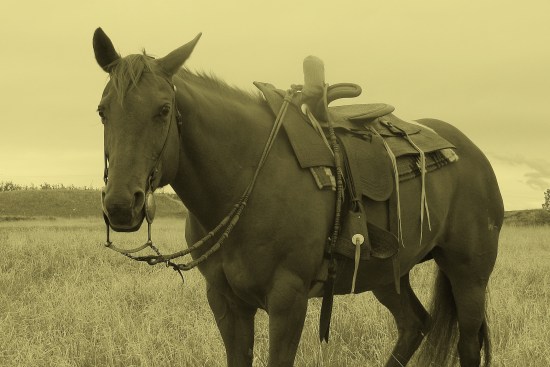
A couple weeks ago we had a visit from Lee McLean, who hales from "way down south" - High River, Alberta. She came with a van load of side saddles - English, Western, and even some bare trees - that we could examine and measure to our heart's content. The plan was to see if we could figure out how the "really good one" was made and why it worked well while others that looked nice were harder to ride. I don't think we completely solved the mystery, but we all learned new things about side saddle design and how finicky it can be.
I have always said that as a general rule, the best saddle makers are the ones who have spent a lot of hours with their backside on the top side of a saddle. By using a saddle in many different ways you learn how you need it to function, and then a saddle maker's mind goes on to figure out why it functions that way. Since neither Rod nor I have ever ridden side saddle, we don't have that "top side" knowledge - but Lee does. She has been riding side saddle since she was a girl. She even went to England as a teenager for a summer to learn more from some very well respected trainers. She also teaches women to ride side saddle properly, so she knows what works and what doesn't work in a side saddle.
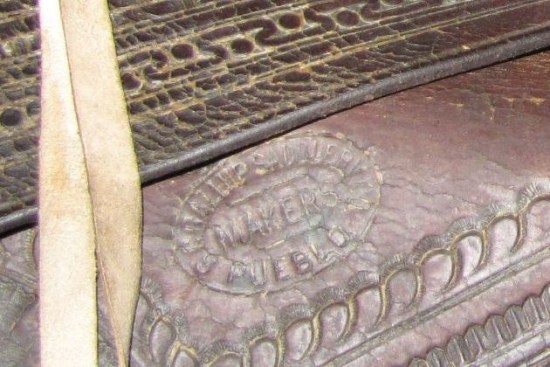
While Lee brought a lot of side saddles with her, the one we spent the most time with was her SC Gallup side saddle. SC Gallup was the saddle maker commissioned in 1870 by Charles Goodnight (of the Goodknight-Loving trail fame and apparent inventor of the chuck wagon) to build a workable western side saddle for his wife, Molly. Lee's side saddle has the maker's mark of SC Gallup, Pueblo, Colorado on it, so we know it was built before he teamed up with RT Frazier when the company became known as Gallup and Frazier. (That happened in 1880 or 1892, depending where you look on the net for your information.) Lee says this saddle is one that just about everyone gets along with, so we used it as our prototype and measured it up, down and sideways. Lee even allowed us to put masking tape on it to mark things like the center line as we did our measurements!
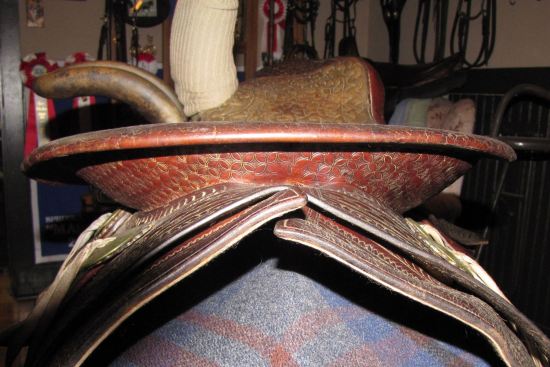
So - what did we find? Well, we spent a lot of time examining the seat. Starting at the back - the cantle was level side to side. While this shouldn't be overly surprising, it actually is something that was good to confirm. Why is that?
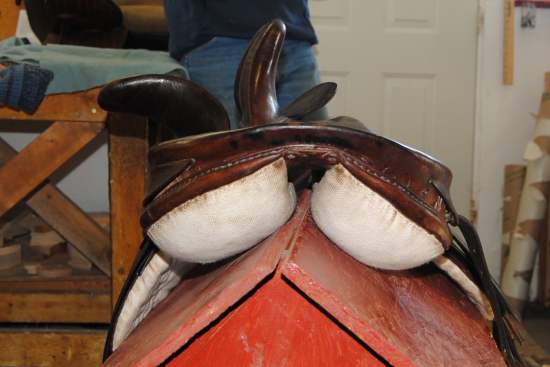
Because English side saddles may have level cantles, but they are unevenly flocked, with extra flocking added to the back of the left panel so when sitting on something level - like a stand or a horse prior to someone mounting, the left side is higher than the right. When mounted, these saddles ride level - which may explain why when a study was done with a pressure sensor pad, they found higher pressures under the left back quadrant on the English side saddles they tested.
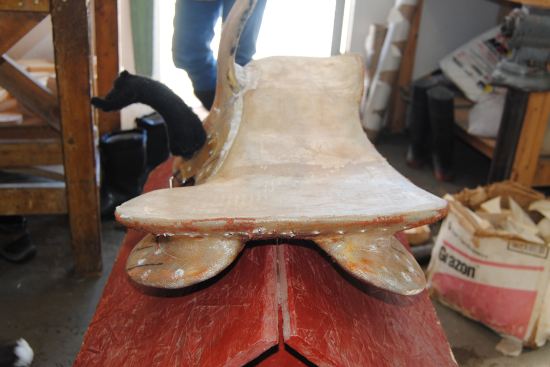
And then there are side saddles that slant to the left. Lee brought this tree to show us how not to build a side saddle tree. She was given this saddle after it was proven to be basically unrideable. She took it apart to see if there was anything that could be done to redeem the tree, but decided she couldn't. People who try to ride trees built like this are always twisted and leaning to the right so they don't slide off the left side of the horse.
So - cantle level side to side: Check!!
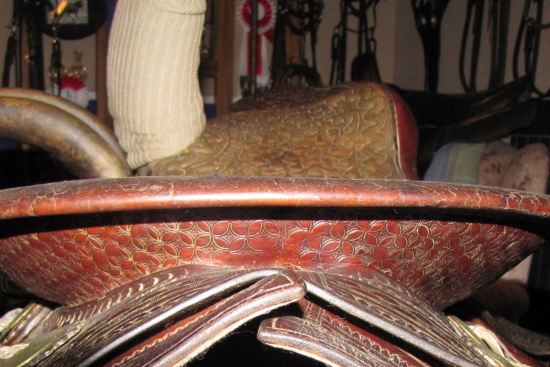
But it isn't level at the front where the rider's leg is next to the fixed horn. There it is sloped a little bit to the left, helping the rider keep her leg tight to the horn.
So - slight slope to the left next to the fixed head: Check!!
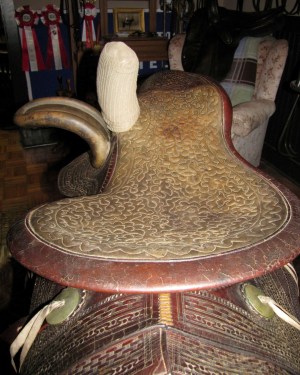
We also found that the cantle isn't even side to side. It is actually harder to see in real life than in this picture, but we found a couple ways the cantle is asymmetrical. First, it is 1/4" wider on the left than the right. Not a lot, but a little. (Some of the other saddles were offset more to the left than this one. Obviously, this is enough for this design.) Second, the shape isn't totally even side to side either. It curves ahead more on the right side than the left. We took a pattern off this cantle and when folding it over, there is over 3/4" difference side to side, yet prior to actually making the pattern, it was really hard to tell if it was symmetrical or not.
This design is quite ingenious. Lee commented that everyone who rode in this saddle seemed to be sitting straight and even on the horse. When both Rod and I sat on the saddle, with instruction from Lee in her proper "instructor's voice", we were told to start with our right leg astride. Then we were asked to lift it up, without moving our hips, and snug our knee around the fixed head with just a little room to spare. But practically, when you do that, you can't help but shift your right hip a bit forward. So the maker of this saddle recognized that inevitability and designed his cantle to make it look like you were sitting evenly - even if you weren't. Brilliant! (Actually, in looking at some of Lee's other saddles and at some copies of the old ones, this shape was present. It was just much better hidden with this saddle!)
So - asymmetric cantle pattern: Check!!
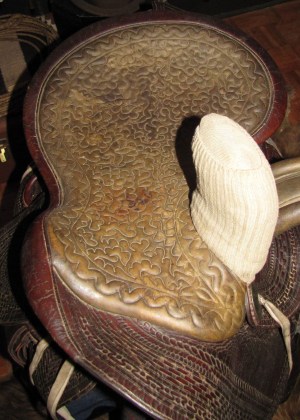
Looking at the front, we all thought that the rider's leg would be centered over the middle of the saddle. Nope. When we put the tape down the center line (which we based off the center of the tree from the underside), it soon became obvious that more of the rider's leg was right of center than was left of center. This will lead to interesting issues in getting the fixed head far enough left for thinner legged women while still having the proper bar spacing for today's horses. A lot of women already use what they call a queen on their fixed head. Basically, a queen is extra padding to help keep their leg to the right. (You see all sorts of different colors on queens, and sometimes white socks too... As Lee said, "Vet Wrap is our friend!!") So we measured legs and spaces from center to fixed head and center to right side and worked out some formulas we will be trying out to get the spacing correct for the rider who is ordering the tree.
So - formula figured for distance from center to fixed head based on rider's leg: Check!!
The distance to the right side at the front is also important according to Lee. She likes the leg to nestle in between the fixed head and a very small right ridge. The size and shape of that ridge varies a lot between different side saddle styles.
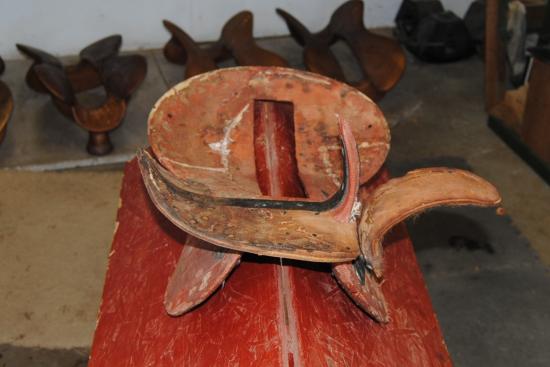
This is what is called a "catalogue" side saddle tree. Late in the 19th century a middle class woman could buy a side saddle via various catalogues. They were relatively inexpensive and, looking at the tree with our eyes, not very well built. You will notice how far to the right the front piece goes on this tree, and there are a fair number of saddles still in use with this design. But Lee feels the more narrow front helps the rider keep in position better.
So - formula figured for width between fixed head and right "pommel": Check!!
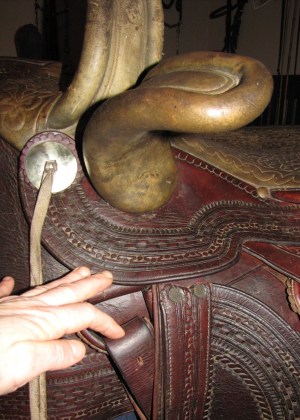
Something else we spent a lot of time discussing was the position of the horns. The leaping horn was an innovation from about 1830 or so, with some dispute about the inventor. However, this second horn allowed the rider to be much more secure on the horse in times of need, such as jumping or other "acrobatic manoeuvres", planned or not... Lee told us that actually it is your right leg going around the fixed head and then pressing in to the left side of your horse that keeps you really secure normally. The leaping horn is only used for jumping or emergencies, at which point if you squeeze your legs together against the horns, you can ride out just about anything.
However, the position of these horns relative to each other is important. If the leaping horn is too far back or too far down, it can hinder the rider from sitting correctly, but how it needs to be positioned can also depend on the rider's leg length, etc. So some side saddles have an option of two different places to screw the leaping horn into the tree. This saddle just had the one place, which was pretty much directly below the fixed head.
So - position of leaping horn options relative to fixed head determined: Check!!
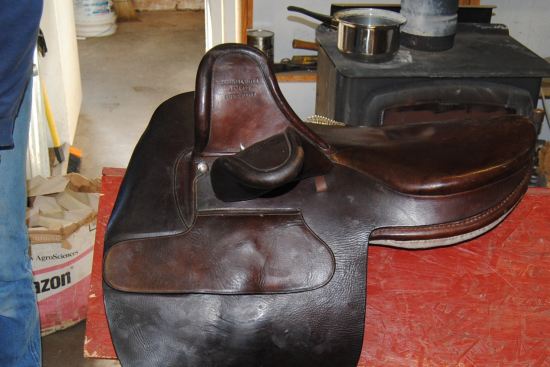
The shape of the horns can vary depending on the maker and the time period. Most Western side saddles have the narrower horns, but here is a picture of a Champion and Wilton English side saddle with larger, triangular shaped horns. Lee prefers this horn shape as it has more surface area to distribute pressure over the rider's leg, thus decreasing pressure in any one area. (Sounds like a familiar concept...)
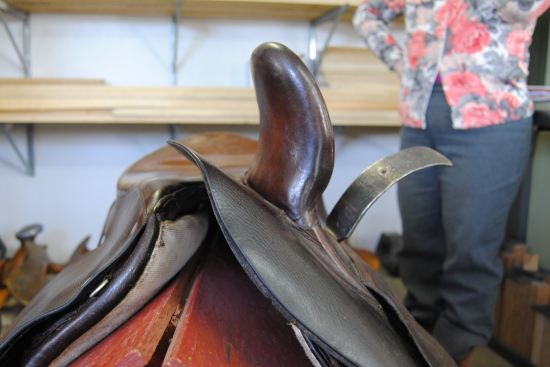
However, the strength and shape of the leaping head comes from a narrow metal piece, even with the triangular shape. This is because the leaping horn often needs to be reshaped to the current rider's left leg shape, and you can't do that with wood. Therefore much of the leaping horn is the result of the saddler's art. How much of the fixed head is leather and how much is tree - only the saddler knows for sure... But we also took a pattern for a triangular shaped fixed head, and can build that now as well as the more traditional narrow ones. You will also notice that the fixed head is set at a bit of an angle. It's not parallel to the horse's midline.
So - patterns and options for shape and angle of fixed head: Check!
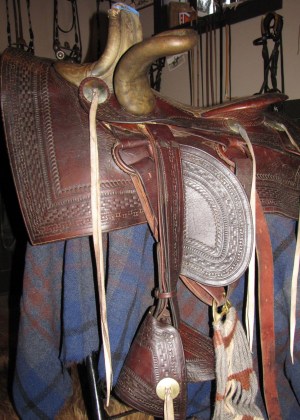
The other thing we noted was that the position of the stirrup leather attachment was almost underneath the leaping horn. Where that stirrup is attached is important to the balance of the rider. Too far back and it makes it hard to keep your hips even and you end up twisting your body. Since it is hard enough (apparently) to keep the right shoulder back so you are sitting square on your horse, the last thing you need is to be fighting to keep your stirrup forward. You can see the tapadero, original to the saddle, which was meant as a safety factor to keep the rider's foot from going through the stirrup.
So - position of stirrup bar relative to leaping head determined: Check!!
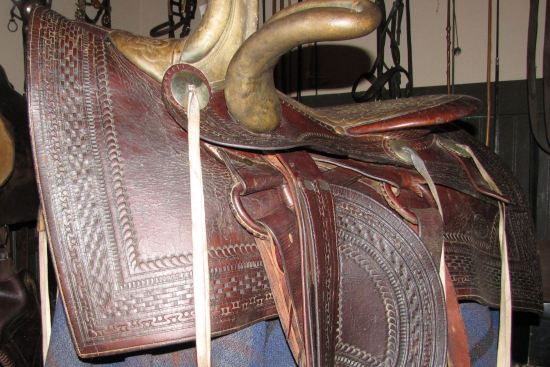
This saddle, like all old western side saddles, is double rigged. English side saddles are officially only single rigged, but have a "balance strap" that goes diagonally under the horse from the back right to the front left of the saddle, attaching ahead of the billets on the left. This is supposed to help keep the saddle from twisting or being pulled to the left. The normal double rigging on a western saddle should do the same thing, though some people innovate a little...
So - determining rigging position relative to fixed head: That's up to the saddle maker!!
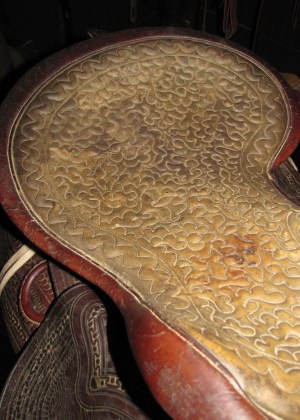
We were both amazed at the workmanship in this saddle, so I thought I would show you a few more pictures. The stitching on the seat is intricate and beautiful, but is still comfortable for the rider.
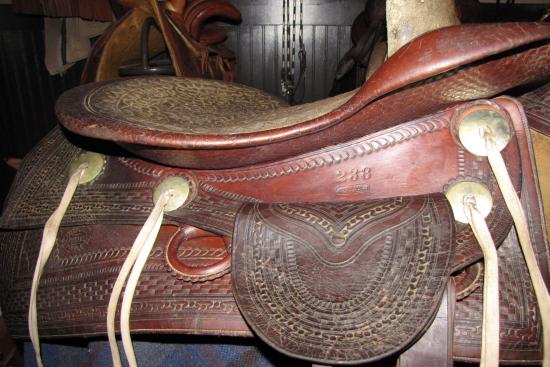
There is a small pocket on the off side in which the lady may keep whatever she may need during the ride. You will also notice the extra leather on the right front corner which could act as a bit of a hand hold if needed. Some saddles actually had a hand hold built in here. (Lee says it is actually better to grab behind your right hip if you have to rather than up front.)
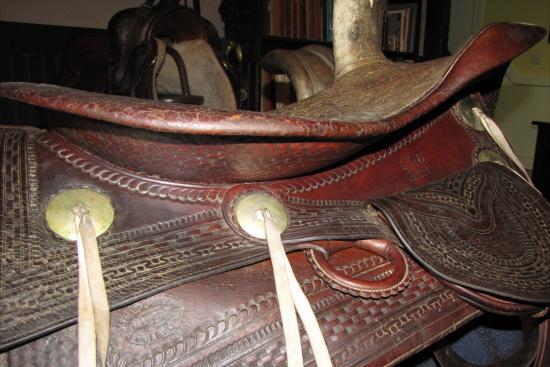
The stamping is intricate, and extremely well done. This is a saddle that any saddle maker - side saddle or astride - could study for a long time and still be learning things.
So armed with more information, we plan to be building a tree for Lee when we get to her order in the line up. It is pretty unusual for a saddle maker to go to this much effort to help us get things right, and we sure appreciate Lee making the long drive north. Well, actually the drive north wasn't so bad. Apparently the drive south had snow and bad road conditions, so we really appreciate Lee coming up to show us her saddles in February in Alberta. We are always open to learning, and this was a great opportunity. Now, we just have to get south sometime in the next year or two to try out the finished product and see how it really works...
By the way, Lee also owns Keystone Equine where she trains and sells top quality horses and ponies for riding and driving and, as I said earlier, she also teaches people to ride side saddle. Besides that, she's a fun lady to visit with!
